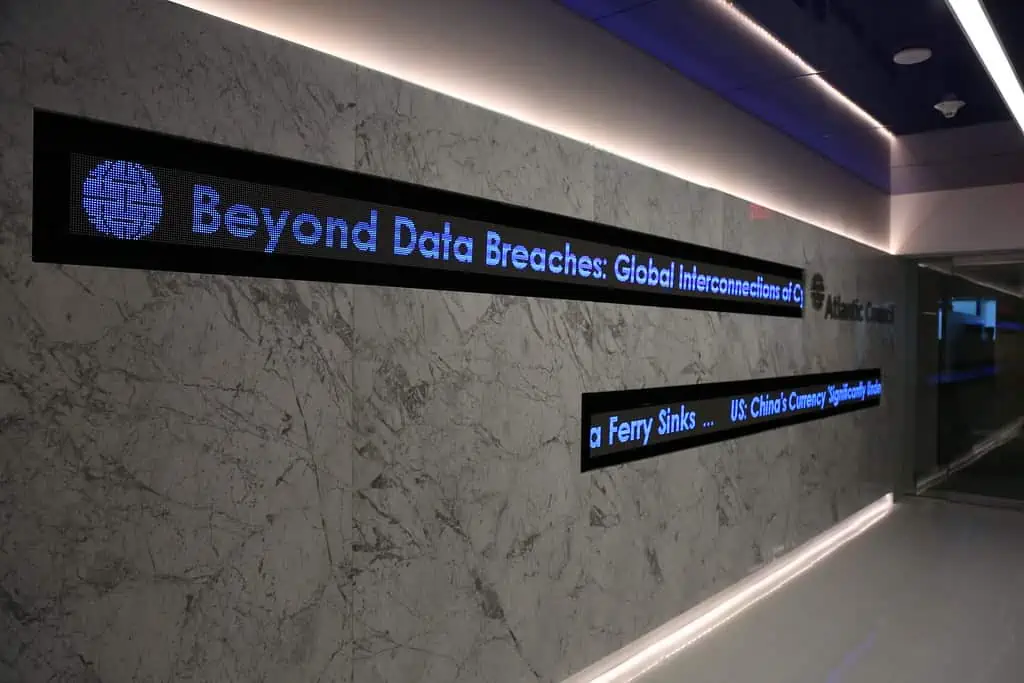Data breaches have become a common occurrence in today’s digital world. It is essential to understand what data breaches are, the real-life examples that demonstrate their dangers and the lessons learned from these incidents. In this blog post, we will delve into all of these topics to provide you with valuable insights into protecting your personal and professional information.
Table of Contents
What are Data Breaches?
Data breaches refer to incidents where unauthorized individuals gain access to sensitive information belonging to an individual or business. These breaches can occur through various means, including hacking and phishing attacks, as well as physical theft of devices containing the data. The consequences of a data breach can be severe, ranging from compromised privacy to financial losses for affected parties.
Regularly updating and monitoring security systems can prevent data breaches and minimize their impact, making it crucial for businesses and individuals to prioritize security measures.
In today’s digital age, security measures are essential in safeguarding against potential data breaches. Regularly monitoring and updating systems can help prevent unauthorized access from occurring while minimizing the impact if a breach does happen. It is crucial for businesses and individuals alike to prioritize security measures in protecting sensitive information and mitigating the risks associated with potential incidents.
Definition of Data Breaches
A data breach refers to an incident where sensitive or confidential information is accessed, stolen, or disclosed without authorization. Sensitive information that can be compromised during a data breach includes personal identifiable information (PII), financial records, medical records, and intellectual property. In addition to the loss of trust from customers and partners, businesses that experience a data breach can face significant legal and financial consequences such as fines, lawsuits, reputational damage and lost revenue.
Companies have a legal obligation to protect their customer’s private information under various privacy laws like GDPR in Europe or CCPA in California. A single security incident may lead to millions of dollars in damages for companies which fail to safeguard user’s privacy rights adequately. Hence it is essential for businesses across all industries including healthcare providers, retail stores and banks among others must take necessary precautions against data breaches by investing heavily in cybersecurity measures such as encryption technologies – both at rest & transit phases-, multi-factor authentication systems while also conducting regular security audits.
Types of Data Breaches
Malware attacks, including ransomware and spyware, are a common type of data breach that can have severe consequences for businesses. These incidents involve the use of malicious software to gain unauthorized access to sensitive information or systems. Ransomware attacks can result in valuable data being held hostage until a payment is made, while spyware breaches allow hackers to monitor activity on affected devices and steal confidential information.
Phishing scams and social engineering tactics used to gain access to sensitive information are another prevalent method of breaching security. Cybercriminals will often pose as trusted sources or create fake websites designed to trick individuals into providing login credentials or other personal details. With this information, they can easily gain access to private accounts and compromise sensitive business data.
Insider threats such as employees stealing or mishandling confidential data remain an ongoing challenge for organizations seeking greater protection of their privacy assets. Human error remains one significant factor leading up these types of incidents since it is hard controlling human behavior 100% all the time which makes it difficult for companies even if they deploy strict policies around handling private records; hence regularly educating employees about best practices may help reduce the risk of insider breaches taking place.
What steps should I take if I’m the victim of a data breach?
Being the victim of a data breach can be a stressful and concerning experience. Here are the steps you should take to help protect yourself and your information:
1. Change your passwords: The first thing you should do is change your passwords for all of the accounts that may have been compromised. Make sure you use a strong and unique password for each account.
2. Monitor your accounts: Keep an eye on your bank and credit card statements, as well as any other accounts that may have been affected. Look for any suspicious activity or transactions and report them to the relevant financial institution immediately.
3. Notify the relevant authorities: Depending on the severity of the breach, you may need to notify local law enforcement or government organizations such as the Federal Trade Commission.
4. Contact the company or organization that experienced the breach: If your personal information was compromised as a result of the breach, contact the company or organization that was responsible for the breach. They may be able to provide you with additional information on how to protect yourself.
5. Consider freezing your credit: If you’re concerned about identity theft or fraud, you may want to consider freezing your credit. This will prevent anyone from opening new accounts in your name.
6. Stay vigilant: Even after taking these steps, it’s important to continue to monitor your accounts and be aware of any suspicious activity. Keep your personal information safe and secure to help prevent future breaches.
By taking these steps, you can help protect yourself and your information in the event of a databreach. It’s also important to remember that prevention is key. Regularly updating your passwords, using two-factor authentication, and being cautious of suspicious emails or links can help reduce the risk of a breach occurring in the first place. Additionally, consider using a reputable identity protection service to help monitor your accounts and alert you of any suspicious activity. As technology continues to evolve, it’s important for individuals to stay informed and take proactive steps to protect their personal information.
Real-Life Examples of Data Breaches
In 2013, Target experienced one of the largest data breaches in history, affecting over 40 million customers. The hackers gained access to customer credit and debit card information by exploiting vulnerabilities in Target’s payment system. As a result of the breach, Target faced significant financial losses and damage to its brand reputation.
In 2014, Yahoo suffered a massive data breach that impacted all three billion user accounts on its platform. The hackers were able to obtain sensitive personal information such as names, email addresses, dates of birth and security questions/answers. This incident highlighted the importance of ensuring robust cybersecurity measures are implemented and regularly reviewed to prevent similar attacks from occurring in future.

Target Data Breach
Unauthorized access to customer information is one of the most damaging consequences of a data breach. In 2013, Target experienced a massive data breach that affected over 40 million customers. Hackers gained unauthorized access to credit and debit card information, as well as personal details such as names and addresses. This resulted in significant financial losses for both Target and their customers.
Data encryption is crucial when it comes to protecting sensitive information from being accessed by unauthorized parties. Unfortunately, at the time of the Target data breach, only partial encryption was implemented on some systems instead of full encryption on all payment cards. This made it easier for hackers to steal valuable personal information.
The impact on company reputation can be severe after a data breach occurs. In the case of Target’s security incident, they suffered not only financial losses but also reputational damage due to negative media coverage and loss of consumer trust.
Key takeaways:
- Unauthorized access can lead to significant financial losses.
- Full-data encryption protects sensitive customer information.
- The aftermath can tarnish a company’s reputation leading to further damages beyond monetary loss
Yahoo Data Breach
When it comes to password management best practices, using unique and complex passwords for each account is crucial to protecting yourself from data breaches. It’s also important to use two-factor authentication whenever possible. For email phishing scams, education and awareness are key in detecting them before falling victim. Be wary of suspicious emails asking for personal information or containing urgent requests. Delayed notification of a data breach can lead to severe consequences such as stolen identities or financial loss, highlighting the importance of timely communication and remediation efforts by companies affected by a breach.
Equifax Data Breach
Sensitive information protection measures are crucial for companies that process and store customer data. The Equifax Data Breach, which affected over 147 million people in 2017, was caused by the failure to implement basic security measures such as timely software updates and encryption of sensitive data. IT Security teams play a critical role in preventing breaches by ensuring that security protocols are up-to-date, conducting regular vulnerability assessments, and providing employee training on cybersecurity best practices.
The #StopTheBreach campaign highlights the importance of public awareness in mitigating the impact of data breaches. In response to Equifax’s breach, this campaign called for increased transparency from corporations regarding their handling of sensitive information and urged individuals to take proactive steps such as monitoring their credit reports regularly. It is essential for organizations to prioritize cybersecurity efforts while simultaneously educating customers on how they can protect themselves from potential threats arising from a breach.
Marriott Data Breach
The Marriott data breach in 2020 serves as a cautionary tale for organizations to not only secure their own systems but also carefully vet any third-party vendors they work with. The breach, which affected millions of customers, was caused by hackers exploiting vulnerabilities in the reservation system of a third-party vendor.
Lessons learned:
- Third-party Risks and Vetting Procedures
Organizations must assess and manage the risks associated with their third-party vendors and ensure that proper vetting procedures are in place before partnering with them.
- Security Incident Response Plans
Having a well-defined protocol for responding to security incidents can help minimize damage and prevent further breaches from occurring. In the case of Marriott, prompt action could have led to mitigating some of the damage caused by the breach.
- The cost of data breach remediation
Data breaches can be costly both financially and reputationally. Organizations need to factor these costs into their risk management strategies when considering whether or not to engage in certain business relationships.
Although it is impossible to completely eliminate all risks associated with data breaches, taking proactive measures such as implementing effective security protocols can go a long way toward preventing them from happening at all or minimizing their impact if they do occur.
Lessons Learned from Data Breaches
Data breaches can be devastating for any company. One of the lessons learned from data breaches is the importance of having a strong cybersecurity system in place. This means implementing protocols and tools to prevent, detect, and respond to potential threats before they cause harm.
Another important lesson is the need for a well-developed data breach response plan. Companies should have clear procedures in place to identify and contain such incidents quickly, determine what information has been compromised, notify affected parties as required by law or regulation, and take steps to prevent similar events from happening in the future.
These two lessons highlight how critical it is for organizations to prioritize employee training and awareness around data security best practices as well as implement regular backups and updates of their valuable information assets. By taking these crucial steps towards securing their systems against cyber attacks, businesses can help safeguard sensitive information while maintaining customer trust in today’s digital landscape.
The Importance of Cybersecurity
Data breaches can have significant financial costs for businesses. The average cost of a data breach in the United States is over $8 million, which includes direct expenses such as investigation, remediation and legal fees. Additionally, companies may face indirect costs such as lost productivity and revenue due to damage to their reputation.
Reputational damage from data breaches can have long-lasting effects on a company’s brand image and customer trust. While it may take years to build up customer loyalty, just one incident of compromised personal information can quickly erode that trust. It’s crucial for organizations to prioritize cybersecurity measures and invest in robust security protocols in order to prevent these types of incidents.
Legal consequences are also a risk factor associated with data breaches. Businesses must comply with laws designed specifically for safeguarding sensitive information such as HIPAA or GDPR regulations; failure to do so could result in hefty fines or even lawsuits filed by affected parties seeking damages caused by the breach.
In today’s age where cyber attacks are becoming more frequent than ever before; investing time & resources into ensuring your organization remains secure is essential – not only protecting your company financially but also safeguarding critical consumer data whilst building confidence among stakeholders that you’re handling their information securely & responsibly.
Data Breach Response Plan
Preparation and planning are crucial steps in developing a data breach response plan. This includes identifying potential threats, assessing the risks involved, and establishing clear procedures to handle incidents. Regularly updating the plan is also important as new threats emerge.
Establishing an incident response team is essential for executing an effective data breach response plan. The team should include individuals from across departments with different areas of expertise who can quickly respond to breaches as they occur. Each member of the team should understand their specific role and responsibilities during an incident.
Effective communication with affected parties is key during a data breach incident. Proactive notification ensures that impacted parties have adequate time to take necessary measures such as changing passwords or canceling credit cards. Maintaining open lines of communication throughout the entire process helps build trust between organizations and affected parties.
Employee Training and Awareness
Regular security training for employees is crucial in preventing data breaches. By educating staff on the latest threats and how to identify them, companies can reduce the risk of an attack. Creating strong password policies also helps ensure that employee accounts are secure and less likely to be hacked. Limiting access to sensitive information is another key aspect of employee training, ensuring that only those who need to know have access.
In addition, regular reviews and updates of security protocols can help keep employees up-to-date with new threats and ways to protect themselves against them. This can include phishing scams, malware attacks or social engineering tactics used by cybercriminals seeking unauthorized access into company systems.
Ultimately, investing in employee training and awareness around cybersecurity is a proactive way for businesses to prevent data breaches from happening in the first place. It’s better to be prepared than suffer the financial repercussions of a breach later on down the track – both in terms of recovering lost or stolen data as well as reputational damage caused by negative media attention or loss of customer trust.
Regular Data Backups and Updates
Regular Data Backups and Updates are critical to protecting your business’s information from potential data breaches. Outdated systems or software can pose significant security risks to your company’s network, increasing the likelihood of a breach. Frequent system updates can help limit the risk of future attacks by implementing security patches and fixing vulnerabilities.
To ensure that your company’s data is always safe, consider implementing these practices:
- Regularly back up all critical information
- Update software and operating systems frequently
- Review hardware on a regular basis
Remember that prevention is key when it comes to cybersecurity. Don’t wait until a breach occurs before taking action – regularly backing up data and updating systems can save you time, money, and headaches in the long run.
In today’s technology-driven world, protecting sensitive information is crucial for businesses to maintain their reputation and financial stability. Cybercriminals are continually finding new and sophisticated ways to infiltrate company systems to steal data, causing devastating consequences for businesses and their customers.
To prevent data breaches, companies must invest in cybersecurity measures to make their users feel safe, protected, and secure.
Conclusion
Data breaches can have severe consequences for businesses and individuals alike. It is essential to prioritise cybersecurity measures such as implementing a strong response plan, conducting regular employee training and awareness programs, and ensuring that data backups are up-to-date. With the increasing frequency of cyberattacks, proactive measures cannot be overlooked.
Ultimately, preventing data breaches requires ongoing vigilance in maintaining security protocols. The lessons learned from real-life examples demonstrate the need for constant improvement and adaptation in response to evolving threats. By prioritizing cybersecurity measures at all levels of an organization, companies can mitigate risks and protect sensitive information from falling into the wrong hands.





